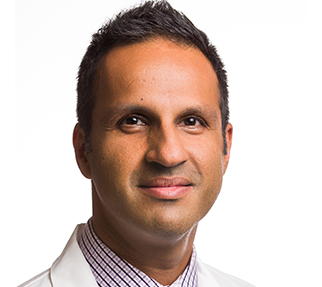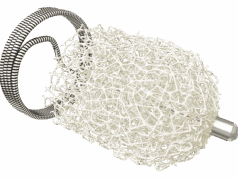
Embolectomy for stroke with emergent large vessel occlusion is highly stressful, even for the most experienced interventionalists. It involves working in hostile anatomy, time pressure, moving and uncooperative patients, technical challenges and there are high stakes involved. These are exciting times, but also challenging times. Pride, ego, and turf have no place in patient care, writes Manraj Heran.
Stroke. Few words strike fear in people the way stroke does, with it being the leading cause of disability in North America, the third leading cause of death, and a dominant cause of expenditure of healthcare dollars. Although considerable progress has been made in the prevention and medical management of stroke, the jury was still out on the value of intra-arterial stroke intervention. This all changed with the publication of five landmark trials in 2015, all demonstrating undisputable clinical benefit to appropriately selected patients able to have embolectomy for stroke with emergent large vessel occlusion (ELVO) via modern day mechanical thrombectomy techniques. This represents the greatest advance in acute stroke management in over two decades. Meta-analysis of the pooled data of these trials has demonstrated a number needed to treat of 2.6. Remarkable, as the number needed to save a life with rapid defibrillation for cardiac arrest is 2.5.
This has created profound challenges internationally, as the level one evidence for thrombectomy has led to a new standard of care. From politicians to hospital administrators to patient advocacy groups and stroke care providers, there is a demand that endovascular stroke treatment be incorporated into practice effective immediately. However, many issues need to be addressed. Key features, such as “door to recanalisation times” of less than 60 minutes, highlight the extremely efficient and expert nature of the trial centres, but will present profound challenges to most non-tertiary care or community hospitals, as the success of stroke thrombectomy is undeniably dependent on multiple factors, not just the training and expertise of the interventionalist. Goyal et al (see article on page 31) speak of “TEAMWORK”, where each of these letters serves as a critical element in achieving the success demonstrated by these trials. Expert proficiency in all of the major contributing components is key for timely salvage of compromised brain tissue. However, many people continue to be ineligible for this treatment due to the lack of commitment of appropriate resources to build the necessary infrastructure to support all aspects of stroke care, not just embolectomy for ELVO. With respect to endovascular stroke treatment, the fundamental philosophical issue of who should be providing this care is no better highlighted than by the criticisms directed at the current consensus training guidelines published by Frei et al in April, 2016 in the American Journal of Neuroradiology. At the core of that document is the principle that achieving the best possible clinical outcomes with embolectomy requires structured training and education of the physicians providing this form of care, in the setting of comprehensive stroke centres able to rapidly triage, assess, and accurately diagnose those patients eligible for this treatment. This expectation is endorsed by every major neurointerventional society throughout the world, but is considered elitist and exclusionary by many who do not have this training or experience. The argument is that challenges in access to individuals who meet these training guidelines, whether it be due to geographical or manpower limitations, practice structures, or hospital credentialing, severely limits the number of people who may benefit from this treatment. So, the real question: is this a realistic training and performance standard for individuals with catheter skills from other circulations to perform thrombectomy? Are there circumstances in which we should make exceptions to these guidelines to expand our ability to offer this treatment to more people?
The importance of organ-specific training and adherence to rigorous quality improvement metrics with minimum volume requirements for maintaining the expected standard of care demonstrated through these recent trials is not new and is seen in all areas of medicine. Conners et al developed stroke training guidelines in 2009, when intra-arterial thrombolysis had demonstrated efficacy for extending the time window to treat ischaemic stroke. This need for extensive training in organ-specific vascular intervention is perhaps best demonstrated in the training required to perform coronary intervention. The American College of Cardiology states that in addition to 24 month core training, as well as the performance of 300 diagnostic coronary angiograms required to become a diagnostic cardiologist, an additional 20 months of supervised cardiac catheterisation with at least 250 supervised coronary stent procedures is required as a minimum acceptable standard before being considered competent to perform coronary interventions. Is the brain less complicated than the heart that we would accept individuals performing stroke thrombectomy without demonstrating acceptable knowledge and experience in treating stroke? Is this really something that can be picked up through a couple weekend courses, online training, and simulator work? The physician performing embolectomy must have the requisite knowledge and training to appreciate the neuroanatomy, neurophysiology, and pathophysiology of the wide range of clinical and angiographic presentations of ischaemic stroke, as well as the nuances of available therapies and treatment options. Acceptable proficiency in performing endovascular stroke treatment requires expertise in relevant neurocritical care, all forms of neuroimaging (CTA, MRA, conventional catheter angiography, cerebral perfusion studies), and extensive experience in manoeuvring devices, catheters, and wires in the cervical and cerebral circulation.
Embolectomy for stroke with EVLO is highly stressful, even for the most experienced interventionalists. It involves working in hostile anatomy, time pressure, moving and uncooperative patients, potential for profound technical challenges, and there are high stakes involved. These are exciting times, but also challenging times. Pride, ego, and turf have no place in patient care. We should strive to build, support, and improve on our whole stroke care delivery model, and recognise that short term pains (such as obtaining appropriate training to perform) will pay off in long term gains. Though “sufficient” training is still a matter of considerable debate, a person is not a programme. All involved must accept personal responsibility for his/her role in this team of acute stroke care. Cutting corners will cost lives. We must play to our strengths, and improve on our weaknesses. Our patients deserve it.
Manraj Heran, is associate professor, University of British Columbia, Vancouver, Canada, president, Society for Pediatric Interventional Radiology and director, Diagnostic Neuroradiology Fellowship Program, Vancouver General Hospital, Vancouver, Canada. He is also head, Section of Pediatric Interventional Radiology, British Columbia’s Children’s Hospital, Vancouver, Canada. He has reported no disclosures relevant to this article










